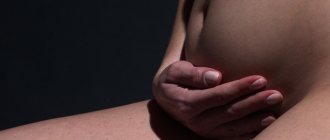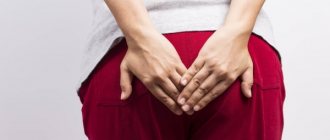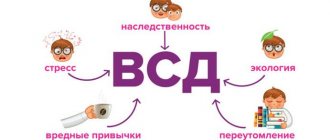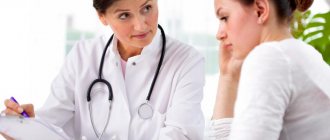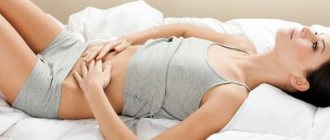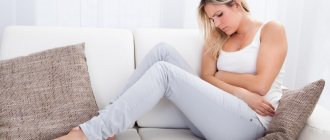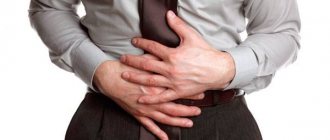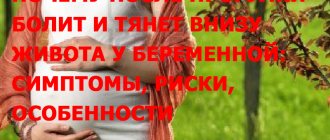What causes pain between the legs in pregnant women - the main reasons
According to gynecologists, severe discomfort during late pregnancy is a normal phenomenon caused by the body’s natural preparation for the birth process. This condition occurs at 36 weeks, since at such a time the baby is already preparing to leave the female body. The stomach drops and puts pressure on the hip joint, causing discomfort.
At 37-38 weeks, the fetus descends and the pelvic bones begin to separate. Since modern man is not trained and has endurance, his ligaments cannot withstand such pressure. Pain occurs, sometimes severe. It is not surprising that hundreds of expectant mothers write messages on thematic forums about what aches and pains between their legs during pregnancy.
However, if severe and sharp pain occurs in the muscles, it is better to consult your doctor. This may be the first sign of miscarriage or premature birth. You should be concerned if such manifestations make themselves felt at 34 weeks or earlier, outside the established time frame.
During pregnancy, obese women also experience leg pain. Sudden weight gain, obesity or a “big” build are the causes of many diseases. Intense pressure is placed on the legs, causing them to ache. This reason is especially typical for thin girls who quickly gain weight.
Another reason why there is pain between the legs during pregnancy is a lack of vitamins. Lack of sufficient calcium and magnesium in the daily diet leads to weakening of the musculoskeletal system.
Doctors note that such symptoms become prerequisites for the following diseases:
- flat feet;
- venous insufficiency (varicose veins);
- arthritis;
- spinal injury;
- thrombophlebitis;
- uterine growth;
- disturbances in liver function.
Therefore, if you are interested in why muscles hurt during pregnancy and what to do with such a symptom, it is better to consult your doctor. He will be able to diagnose and prevent dangerous diseases in time!
Differences in pain depending on location
Pain sensations and the reasons for their occurrence will differ depending on the part of the body where they appear. The options for getting rid of these pains will also differ.
Stomach ache
During the development of the fetus, changes occur in a woman's body. Together with the fetus, the size of the uterus increases; it can increase 25 times. When the child is born, the uterus begins the process of shrinking, that is, it returns to its usual state and again decreases in size. Therefore, the pain in the lower abdomen that a woman experiences may be normal contractions of the uterus.
They may feel like contractions and intensify while the woman is breastfeeding. These sensations are normal from a physiological point of view and such pain does not indicate any disease. The active return to the previous form of this organ lasts 1-1.5 weeks, during this period the most severe pain in the abdomen after childbirth is noted.
It is necessary to distinguish between abdominal pain and navel pain. If a woman has a very large belly during pregnancy, she may develop an umbilical hernia. This is precisely what causes pain not in the stomach, but specifically in the navel area. Although this is a common occurrence, you should not hope that the pain will go away on its own, so contact your gynecologist soon.
If pain occurs in the stomach area and feels like problems with the gastrointestinal tract, then this may be a separate disease of the digestive system. You will feel pain after childbirth because the disease has worsened, so in this case a consultation with a doctor is required. A variety of abdominal pain can begin after taking antibiotics, which also affects the gastrointestinal tract.
Back pain
In this case, there is no need to expect any pain or hope for its absence; this is due to the fact that back pain after childbirth is of an exclusively individual nature. It doesn’t even depend so much on the process of gestation or birth. The absence or presence of back pain after childbirth is due to the fact that the woman’s body individually adapts to these changes. One woman will hardly feel how her back hurts after childbirth, but for another it will be akin to torment.
If we consider this issue in more detail, pain is directly related to the production of certain hormones. After a woman gives birth, the production of hormones will not be as active, and the hormone that was necessary before childbirth is practically not produced, therefore the muscles of the symphysis pubis are no longer as relaxed as we would like. Of course, the reduction of this hormone occurs, although sharply, but returns to normal only within 5 months after the woman gives birth.
The constant influence of relaxin leads to the weakening of the ligaments that are located around the spine, accordingly it loses its former stability, and the consequences of such changes after childbirth are actively manifested.
Lower back and tailbone pain
The lower back and pelvic area are especially actively preparing for childbirth. The lower back, namely the vertebrae of this section, leans slightly back. The area of the hip joint changes due to a kind of stretching of the musculoskeletal system. And the bones in the sacrum area diverge slightly. Changes are noted in the coccyx area; it moves slightly back.
Accordingly, such changes in the human body cannot but have an effect after childbirth. If the birth is not entirely successful, then the sacrococcygeal joint will receive a greater load than what was placed on it. In this regard, pain occurs in the tailbone after childbirth.
Pain in the hip joint may indicate arthralgia. It occurs after physical stress on the joints and ligaments, which is almost impossible to avoid during pregnancy.
Headache
The occurrence of headaches in women after childbirth is influenced by several factors. One of them is hormonal changes in the female body. All kinds of stress and overwork also take their toll, and this can cause a woman to have a headache.
There are also specific causes of headaches that may occur after spinal anesthesia. The drug, which anesthetizes the process, is injected directly into the spine, to the place where the lumbar and sacrococcygeal regions border. This drug affects the woman’s body as a whole, so after spinal anesthesia, a woman most often experiences headaches.
Pubic pain
Naturally, the changes that occur in a woman’s body during pregnancy and childbirth cannot pass without leaving a trace. Pain is felt throughout the body, pain appears in the joints after childbirth. Also, pain often manifests itself in the pubic area when the cartilage connecting the pubic bones was injured during childbirth, for example, this can occur due to the extension of the head of a child emerging from the womb. Such injuries, although not too frequent, are still encountered in medical practice; this pathology is called symphysitis.
If you consult a doctor in time, you can avoid many unpleasant consequences. And although initially there is no particular manifestation of this pathology, except for the pain that constantly accompanies a woman, not only damage to the cartilage can occur in the body, but even its rupture.
Heel pain
Back pain when jumping after pregnancy is due to changes in the spine, but many women notice that their heels hurt during pregnancy.
Such pain can be associated with a fairly sharp increase in a woman’s weight. In ordinary life, the feeling that heels hurt can occur to a person if he has gained significant weight. In a woman during pregnancy, a similar process cannot be bypassed, but the fact that weight gain occurs remains a fact.
In addition to all this, with obesity, the increase in body weight occurs approximately equally in all parts of the body, but during pregnancy the center of gravity shifts, and accordingly, pain of this nature appears. Also in connection with this, there may be stress on the knee, on the entire foot, and in general on the musculoskeletal system of the female body.
Pain in the groin and perineum
Such pains will in any case occur to a woman, no matter whether the birth went quickly and without problems or not. Their duration will be individual for each woman. In any case, the birth of a child is a kind of stress for the body and a big load on the woman’s genitals. Therefore, in case of such pain, it is necessary to consult a gynecologist to make sure that the body’s recovery is proceeding normally. And if any complications arise, then immediately begin treatment of the disease.
Nature of pain
Pain in muscles, bones and ligaments differs in origin and intensity.
In the muscles
The pain is caused by the separation of the pelvic bones and pressure on the ligaments. But this same symptom indicates the development of some disease. It is enough to pay attention to the nature of the sensations for initial self-diagnosis.
When during pregnancy there is slight discomfort between the legs, a little tugging, this is a normal symptom. The sensation is similar to the feeling after a long workout, overworked muscles buzz and ache. Women experience similar pain after intense stretching exercises.
If discomfort occurs when walking, flat feet are suspected. Sharp pains are accompanied by constant cramps. By the end of the day, severe swelling appears and the legs become heavy.
When the calf muscles hurt, there is a risk of developing varicose veins. Then the pain becomes nagging and dull. It begins after a long walk and is accompanied by the appearance of “stars”.
When a woman has pain in her back, tailbone, or groin area, pay attention to the condition of the spine. Various mechanical damage, shifts, hernia, and other diseases are characterized by strong and dull pain. They appear throughout the body, disappearing and appearing.
To the question of who had pain in their legs while carrying a child, you can get many positive answers. In some situations, girls are predicted to have a miscarriage or premature birth.
The real risk appears between 22 and 31 weeks. Then the shooting between the legs becomes unbearable. Accompanied by spasmodic phenomena in the pubic area. Characterized by pain in the lower back. All these signs require immediate medical attention.
The main reason why there is pain between the legs during pregnancy is called excess weight. In this case, the discomfort is not too obvious, but constant. There is heaviness in the legs, not only in the groin, but also in the calf muscles.
In the bones
Bone pain occurs from the expansion of the pelvic bones in preparation for childbirth. Therefore, when there is pain (even very much) between the legs during pregnancy at 30 weeks, there is no need to worry. It is enough just to see your doctor.
Heaviness and nagging pain appear. When bones, muscles and ligaments hurt between the legs during pregnancy, the limbs cannot be moved. Relief appears in a supine position.
Another reason is inflammatory processes caused by infectious diseases. In places where the infection spreads, adhesions appear - fusions of connective tissue. Located in the pelvic area, they cause pain between the legs during pregnancy. The symptom becomes unstable, sometimes sharp. Unpleasant sensations appear in the lower abdomen.
It is not difficult to understand why muscles hurt. The situation is worse with bones, since even such a common disease as arthritis is not diagnosed the first time until later. The discomfort becomes nagging and the lesion spreads throughout the leg.
Lack of vitamins during pregnancy also causes bone pain in girls. This is a dangerous sign leading to the risk of premature birth. The pain is uncharacteristic and often occurs after a long walk. For timely diagnosis, you should pay attention to the accompanying symptoms.
Symphysitis is a pathology caused by mobility of the pubic bone and its swelling. This condition is fraught with caesarean section during childbirth or divergence of the symphysis pubis. It is characterized by acute and sharp pain when changing position in space or posture. Sometimes nagging pain is characteristic.
Why does the pubic bone hurt after childbirth?
There is no clear answer to why this disease occurs. It may result from problems such as:
- increased production of the hormone relaxin, which is responsible for softening the ligaments of the pelvic bones and opening the cervix;
- lack of calcium in the mother's body;
- multiple births;
- traumatic birth - application of forceps, excessive separation of the hips during childbirth, rapid labor;
- large (over 4 kg) fruit;
- inactive lifestyle;
- development of symphysitis in previous pregnancies;
- natural birth with the first or second degree of symphysitis during pregnancy.
How to cope with trouble - tips for expectant mothers
There are two treatment options: medication and alternative. The former should only be used as directed by your doctor. Mindless consumption of painkillers will harm the health of mother and baby!
In case of symphysitis or excessive divergence of the pelvic bones, a bandage or other fixing bandages are used. They will hold your limbs in place, reducing pain and helping to avoid injury.
Doctors recognize physical exercise as a popular way to get rid of pain in the muscles between the legs. A few simple exercises, performed even in the later stages, will quickly cope with the unpleasant symptom. But they should be performed with caution.
When the cause lies in a pinched nerve or other pathologies of the nervous system, it is recommended to alternately apply a cold and warm compress to the sore spot. This will calm the limb a little and temporarily eliminate discomfort.
After walking, if acute and sharp pain occurs, it is enough to lie on your back on a flat and hard surface. Relax for a few minutes and give your body a break from excessive stress.
Have someone build a small bathtub stand. Sitting on it, you can take a warm shower. It relieves tension throughout the body, relaxes and reduces discomfort.
Engage in light self-massage: lightly stroke the skin on your stomach, between your legs, around your thighs. The pain in the muscles between the legs will subside for a while. But they cannot disappear completely, since this is a natural manifestation.
In the evening, after a hard day, take a small foot bath. Add chamomile, lemon balm, mint and calendula. The herbal decoction has a deep relaxing effect on all the muscles of the body.
When will the sutures in the perineum heal after childbirth, and what will help relieve the pain?
During a natural birth, if the baby is large or comes out in a non-standard way, for example, with the butt forward, ruptures of the birth canal and perineum may occur.
In some cases, doctors themselves make a small incision in the perineum during childbirth, if otherwise the child cannot be born. Immediately after birth, these incisions are closed with sutures.
They add additional discomfort and pain after childbirth, and stitches in the perineum are a different story that needs to be experienced.
- How long does it take for internal and external stitches to heal after childbirth?
- Why can stitches hurt?
- What to do if the stitches hurt
- How to care for postpartum stitches
- What to do if the seam comes apart
- When are stitches removed and does it hurt?
Such sutures can be placed on the cervix without anesthesia: its sensitivity in the postpartum period is reduced, but on the perineum without anesthesia it will be difficult to do. And in this case, local anesthesia is used.
But if epidural anesthesia was used during childbirth, it lasts for a long time, and there is no need for additional pain relief when suturing. Sutures after childbirth can be placed on the cervix, vagina, and perineum.
But it is in the latter case that the most severe discomfort and pain can be felt.
How long does it take for internal and external stitches to heal after childbirth?
How long does it take for wounds to heal after sutures during childbirth, and is it possible to speed up this process? In general, everything is individual, it depends on many factors, and not least, on the correctness of the patient’s compliance with precautionary measures . For some things heal faster, for others slower.
The speed of healing is also affected by their location and the type of surgical threads that were used. As a rule, catgut is used to apply internal sutures, which dissolves on its own. In this case, everything heals on average in 2 weeks. If surgical threads are used that do not dissolve, for example, nylon, they are removed on the 5-6th day after application.
And the healing process itself can take from 2 to 4 weeks, and in some cases even longer.
Almost all “affected” mothers are concerned about the question: how to heal sutures faster after childbirth? The speed of healing also depends on the patient herself, on whether she follows all the rules for caring for the injured area, precautions to avoid infection, and not to re-injure these areas. She should be informed about all this in the maternity hospital.
If microbes get on post-mortem wounds, inflammation and suppuration may occur, which will significantly prolong the healing period.
This is a normal phenomenon, because there was a gap. After the anesthesia wears off, the stitches may begin to hurt. The fact is that most young mothers breastfeed their children, so painkillers are contraindicated for them. The doctor can prescribe drugs with local action in order to somehow alleviate the patient’s plight.
However, if everything is in order, there are no complications, and the woman follows all the rules, the pain should go away very soon. After suturing, you cannot sit normally for the first week. This must be done with caution and put stress on the buttock that is located on the opposite side of the seam.
You can sit on the toilet almost immediately, but do not linger on it for too long and do not push too hard.
What to do if the stitches hurt
You need to make sure that everything is fine with them, they are not infected, they have not festered. Otherwise, if this does happen, you should consult a doctor.
He will most likely prescribe special antiseptic drugs. The sutures may hurt due to the fact that the woman sits for a long time, which is undesirable in the first 2 weeks after childbirth.
You can take a reclining position or lie on your side.
Often they may hurt during bowel movements. For this reason, women should avoid constipation. To do this, she must monitor her diet and take, if necessary, approved laxatives.
If the pain is severe, accompanied by itching, redness, and suppuration, you should immediately consult a doctor to prevent the development of more serious complications.
Sometimes, even a year later, the stitches after childbirth make themselves felt, especially when there is additional stress on them.
How to care for postpartum stitches
There is nothing particularly complicated. After each visit to the toilet, a woman must wash herself. The procedure must be repeated 2 times a day using warm water. For now, you should forget about thongs and other fashionable shapewear.
It should be free, comfortable, made of natural, high-quality materials.
Sitting, with the exception of the toilet when visiting the toilet, should begin only after 2 weeks and do this gradually, very carefully, without sudden movements, so that it does not hurt and the stitches do not come apart.
Women are also prohibited from any physical activity, lifting, and carrying heavy objects; they will also need to abstain from sex for 1-1.5 months. Many women, for the sake of their sexual partner, just so as not to upset him, neglect this rule, making it worse only for themselves. But it is worth remembering that an understanding man will not insist on intimacy.
What should be the diet of a pregnant and nursing mother, and what are the features of each period separately?
Information about the pros and cons of tubal ligation, and what consequences may occur after the operation, is here.
Is it possible for pregnant women to have a massage: //budymamoi.ru/pregnant/taboo/massazh-beremennym.html.
What to do if the seam comes apart
If the seam has come apart, there is no need to do anything on your own. It is necessary to call a doctor at home, if possible, or an ambulance. Usually, the stitches are re-sutured. If the wound has already healed, the doctor can simply prescribe special medications (vaginal suppositories, ointments) with a wound-healing effect.
When are stitches removed and does it hurt?
The doctor usually, even when applying stitches, talks about when exactly the woman will need to come to him to remove the threads. If everything is in order, no complications or other problems arose during the healing process, the sutures are removed exactly after the specified period.
The process itself is relatively painless. Internal sutures made of catgut, as a rule, are not removed; they dissolve on their own. Other types of surgical sutures can also be removed relatively painlessly. Although, it all depends on the pain threshold of each individual woman. In the vast majority of cases, no anesthesia is required.
The woman feels a slight tingling, burning sensation. If a woman is in pain, the doctor may use a local anesthetic to make the procedure easier for her.
After the stitches are removed, you should also continue to carefully monitor your intimate hygiene and avoid strenuous physical activity until the wounds are completely healed.
How long does it take for external sutures to heal after childbirth, and how does the recovery period generally go in the video:
Source: //budymamoi.ru/health/pain/shvy-na-promezhnosti-posle-rodov.html
Physical education against the problem
Physical therapy only brings benefits, but it should be used wisely. Exercising too intensely late in life can be harmful. Try to exercise carefully, do not overwork yourself, and then the pain between your legs will subside in the later stages.
A few exercises:
- Kneel, resting on your palms, making sure your back, buttocks and neck are at the same level. Slowly lower your neck down and, on the contrary, arch your back. Repeat several times.
- When your muscles and bones hurt during pregnancy, lie on your back on a hard, flat surface. Move your legs towards you, trying to touch your buttocks with your feet as much as possible. Without changing your position, spread your legs, bent at the knees, to the maximum distance.
- Also lying down, bend your knees and focus on your feet. Lift your pelvis off the floor a little (don’t overdo it!) and lower it back down. Repeat several times.
- Prepare a small support - a small shelf or stool. Lying in the position described above, raise your legs and place them on a support. Hold on for 10 minutes.
- Sit on a hard chair, lean on the back. Raise your leg up and make several rotational movements. Repeat the same with the second limb. This exercise perfectly accelerates the blood and relaxes the muscles.
- Leaning on the back of the chair, sit down a little. Don't try to get too close to the floor or exceed your limit of flexibility - this can have unpleasant consequences. Do it carefully and in small quantities.
- Stand up straight and move one of your legs back a little. Bend your knees slightly, imitating a kind of squat. Then swap limbs.
In the early stages, step exercises can help. Place a small bench or low stool in front of you, first step on it with your left foot, and then “pull up” your right. Get off in the reverse order: the left one steps first, and then the right one stretches.
Doctor's recommendations for prevention
It is not difficult to get rid of the symptoms, but it is better to prevent their occurrence. There are various preventative measures recommended by doctors. Compliance with them is a guarantee of an easy and pleasant pregnancy.
Remember these simple but useful rules:
- Watch your diet. A pregnant woman's diet should be varied and healthy. If necessary, compensate for the lack of vitamins with various pharmacy complexes.
- Drink a lot of water - contrary to popular stereotypes, you should not limit yourself. Try not to eat salty and fatty foods to avoid swelling.
- Walk a lot in the fresh air. Going outside is good for everyone, and the benefits of sunlight have not been canceled. But you shouldn’t constantly stand in direct sunlight: in the summer, walk in the shade.
- Don't lie on the couch all day. Lack of physical activity negatively affects the body and the subsequent course of childbirth. If you were previously an active person, a sudden stop in physical exercise is guaranteed to bring severe discomfort.
- Try not to cross your legs. This is a common habit found in many women. But while waiting for the baby, all the muscles and bones in the body soften, so such a position can harm them.
- Wear comfortable shoes with orthotics. It is better to avoid heels; the maximum height is a few centimeters. If it is not hot outside, it is better to wear shoes with stockings or tights.
Which one should I contact?
If you experience pain after pregnancy, it is best to contact the gynecologist who treated you during pregnancy. He knows all the features of the course of the disease and will be able to determine what is associated with a woman’s back or abdominal pain. If the pain is associated with the birth of a child, restoration of the reproductive system after the birth of the baby, then he will be able to tell if any or everything is going as usual, and if necessary, prescribe treatment. If pain occurs, for example, in the back, he will refer you for examination to another specialist.
Many women believe that visiting a gynecologist after pregnancy is not necessary if the woman feels well. In fact, this is not so; you should definitely go to the gynecologist 1.5 - 2 months after giving birth to make sure that there are no hidden diseases.
It is also worth monitoring the recovery process on your own; exercise should be moderate, food should be healthy, and walks in the fresh air are important.
Why does my groin hurt during pregnancy?
Any minor manifestations of pain are often associated with natural physiological changes in the female body. If a woman has groin pain during pregnancy, then for the most part this indicates an increased load on the pelvic area.
In the early stages, pain in the groin rarely occurs, mainly due to the synthesis of the corpus luteum in the ovaries to produce progesterone. Such an endocrine organ can grow and form a cyst, which will subsequently resolve on its own. In this case, the pain can be both in the right groin and in the left, depending on which ovary the tumor appeared in.
Pathological causes of groin pain during pregnancy
With constant pain, the question of why the groin hurts during pregnancy should be considered in the context of pathological influencing factors. In this case, additional symptoms are always observed, indicating the development of the disease.
If there is colitis or pulling in the groin, the following pathologies are often diagnosed:
- A hernia is a common cause of pain when the abdominal muscles weaken and loops of intestine prolapse, causing pain.
- The infection is characterized by enlarged lymph nodes and pain of varying degrees. If a pregnant woman feels her groin swelling, she will need to consult a specialist, as this may indicate a cancerous tumor, or, less commonly, syphilis.
- Pinching of the sciatic nerve is caused by acute pain when walking, sitting and sudden movements. With this diagnosis, mild painkillers are prescribed, and after pregnancy the pain syndrome disappears on its own.
- Urolithiasis provokes the passage of stones, which, when passing through the ureter, cause stabbing pain radiating to the groin, lower back and hypochondrium.
Ectopic ovarian fertilization is also characterized by pain in the right or left groin, depending on which side the egg was implanted on. Since the fetus cannot grow outside the uterine cavity, immediate surgical intervention is used for this pathology.
In the last three months, groin pain after sleep may be caused by varicose veins. The disease is accompanied by convulsions, the presence of an edematous reaction, which provokes poor blood flow and congestion in the body. It is better to tell your doctor about all painful sensations, because only specialists will be able to accurately determine the etiology of pain and connect the symptoms together to make a diagnosis.
It is no secret that pregnancy is associated with a restructuring of a woman’s entire body. Suddenly it becomes difficult to turn over in bed, acute pain appears while walking or driving a car. The reason for this is pain in the groin area. Why is this happening? Hormonal changes or the manifestation of some hidden pathology?
Pubic pain after childbirth
Under the influence of hormones, which “signal” to all systems of the mother’s body about the end of the birth process, the mechanism of postpartum recovery is launched. And usually, immediately after childbirth, the pubic symphysis (symphysis) is restored, the bones of which diverge slightly during pregnancy.
If everything is normal, then the process of restoring the normal anatomical position of this joint occurs without noticeable consequences.
But if a woman who has given birth complains of pain in the pubis after childbirth, it means that the cartilage connecting the pubic bones is injured due to hyperextension of the pelvic floor (which occurs when the head of the child emerging from the womb is extended). In this case, there is likely to be a violation of the symmetry of the right and left pubic bones. Doctors diagnose this pathology as symphysitis - dysfunction of the pubic joint, in which the patient feels pain in the pubic area when walking and is forced to walk in a waddle.
If the pain is very strong and radiates to all the bones and joints of the pelvis, then this is not just a stretch of the cartilage, but a rupture of the symphysis pubis - symphysiolysis.
Initial stage of pregnancy
This is perhaps the most important and exciting period for every woman. After all, her body is undergoing numerous restructuring and serious changes. They are inevitable and simply necessary for the successful development and growth of the unborn child. Hormonal changes are accompanied by pain and ailments, which bring worries and worries into the life of the expectant mother. Fears about an unsuccessful resolution of pregnancy force her to listen to her body, acutely perceive and react to any manifestation of pain in the lower abdomen.
What's going on anyway?
We must be prepared for the fact that inguinal pain can bother a woman at any stage of the child’s formation and development. The immunity of the expectant mother, especially in the initial stages of pregnancy, decreases. As a result, the body is forced to work “for wear” and sometimes cannot cope with diseases and hidden deficiencies. Chronic processes that have not made themselves felt for years begin to worsen, and weak and especially vulnerable organs fail. Viruses and infections also cause significant harm because the body cannot provide adequate resistance. In addition, obstetric pain complicates the already difficult situation of a pregnant woman.
Let's try to figure out what causes the pain in the groin.
Pregnancy: early diagnosis
There are situations when a woman feels unwell or in pain, but is not aware of her “interesting situation.” Sore throat, chest or stomach pain , muscle aches - it’s not clear what is the reason for this condition?
When a headache or aches throughout the body, a woman often considers this a manifestation of a viral or cold . It’s good when it is treated with folk remedies, for example, tea with honey. When does one start taking medications without seeing a doctor? This is why it is so important to be examined and determine pregnancy, and not to start self-medication.
Once pregnancy is determined, the woman’s duty is to unconditionally follow the doctor’s recommendations, because for the remaining nine weeks the principle “do not harm the child” will be dominant in her life. Pain in the early stages of pregnancy may indicate a complex disease, which sometimes requires surgical intervention.
Perineum hurts after childbirth: causes, possible problems and advice from gynecologists
In this article we will look at why the perineum hurts after childbirth and what to do in this case.
The perineum is the area located between the anus and the vagina. During a natural birth, she experiences a lot of pressure and strain as she is stretched so much so that the baby's head can fit through the opening. Since there is a strong stretching of the tissues, women have pain in the perineum after childbirth.
Discomfort without incisions
Women who did not have incisions during childbirth are very surprised, feeling discomfort and heaviness in the vulva area. Therefore, logical questions often arise about how much the perineum hurts after childbirth.
If this process took place without additional medical intervention, then pain in the muscles of the vulva bothers the woman for about 7-8 days after the birth of the child. This process is normal and represents a recovery period when the muscles return to their previous state.
The nature of the pain that arises resembles the soreness that occurs when soft tissue is bruised.
In some cases, as a result of childbirth, a woman may experience swelling on the labia majora, as well as slight blue discoloration.
In addition, if a woman does not have enough subcutaneous fat in the vulva area, she may feel that her perineal bones hurt after childbirth. In this case, there is no need to be afraid - the discomfort from the bruise simply radiates into the tissues located nearby.
Ways to alleviate the condition
To alleviate her own condition when the perineum hurts after childbirth, a woman is advised to follow certain recommendations:
- On the first day after discharge from the maternity hospital, the woman should be provided with bed rest. The most correct position in this case would be the so-called star pose: the young mother should be on a bed covered with a special hygienic diaper, without underwear or trousers. The legs should be positioned in such a way as to provide air access to the wound area.
- The injured area should not be touched; personal hygiene procedures should be performed with caution, directing warm water to the bruised area.
- It is recommended to use special sanitary pads designed for women in labor (they are made of cotton, do not have texture or fragrance). Replacements should be made at intervals of 2-3 hours to avoid disputes.
- It is not recommended to use toilet paper; you should wash with warm water.
- Some doctors advise placing the pads in the freezer for a short time before use. In this case, the hygiene product will be cool, which will reduce discomfort.
- If discomfort occurs when sitting, it is recommended to purchase a special pillow from an orthopedic store and place it under the buttocks.
- It is allowed to take baths based on chamomile infusion. Daily baths for 5-10 minutes will significantly reduce pain.
- It is allowed to use Ibuprofen in the first three days, but only if the doctor allows it.
- If the discomfort persists for more than 10 days, you should consult a gynecologist. He will examine the woman and, if there is no pathology, recommend the use of a special cooling gel or painkillers.
Tears, cuts
Many people wonder why the perineum hurts after childbirth. The process of natural childbirth does not always go smoothly.
Quite often the fetus is large, and the female pelvis is not designed for such expansion.
In order not to injure the newborn and not cause unnecessary pain to the woman, obstetricians make an incision in the perineum to widen the exit for the normal passage of the baby's head.
Incisions are also made to prevent rupture.
This is due to the fact that smooth tissue is easier to stitch than lacerated wounds, and in this case it heals faster, and the likelihood of bleeding is much lower.
Sutures are placed at the incision site with non-absorbable threads. In fact, it's a small operation. Pain after childbirth, during which women received stitches in the perineal area, persists for approximately 3-4 weeks.
Internal seams
In addition, internal seams can cause discomfort. They are applied if there are ruptures in the womb or cervix during childbirth.
Scars of this nature heal quite quickly, and the threads completely dissolve or come out through the vagina.
Internal sutures cause much less discomfort in a woman, the intensity of pain in the perineum is lower, and it persists for up to 21 days.
Seam care rules
The most important aspect in caring for sutures is hygiene, since their danger lies in the possibility of suppuration or infection. Infection of the vulva is fraught with penetration of the virus into the uterus and the development of endometritis, which is long and difficult to treat. The basic rules for caring for seams are as follows:
- Hygiene procedures should be carried out twice a day, using warm water and antibacterial soap.
- You should use special sanitary pads to prevent friction and itching in the perineum.
- After each visit to the toilet, you must wash yourself using warm water.
- During the first three days, the seam should be treated with an antiseptic. You can use Miramistin, hydrogen peroxide, or any other drug that does not cause irritation or burning.
- If the sutures are located in the vagina, treatment can be carried out using cotton wool, which is completely saturated with an antiseptic.
What if the perineum hurts for a long time after childbirth?
Situations in which you should consult a doctor
You should contact your gynecologist if the following symptoms are observed:
- An increase in temperature in the absence of any external factors.
- Discharge of large amounts of pus.
- The appearance of unpleasant discharge that has a yellow-green color and a putrid odor.
- Increased swelling, edema.
- Seam divergence.
Self-medication and the slightest delay in such a situation can lead to dangerous consequences.
We looked at what it means when the perineum hurts after childbirth.
Source: //FB.ru/article/462661/bolit-promejnost-posle-rodov-prichinyi-vozmojnyie-problemyi-i-sovetyi-ginekologov
Why does groin pain occur in the second and third trimester?
From the second trimester of pregnancy, groin pain begins to bother almost all pregnant women. If in the first trimester pain is usually associated with hormonal changes in the body, then later a natural reason comes into play. The baby’s weight increases every day, the tummy grows and with it the load on the pelvic organs and back increases. This causes the muscles to stretch and cause pain. The body is preparing for labor, which also causes pain: each ligament that attaches the uterus to the walls of the pelvis is stretched, and the bones, in turn, soften a little. Weak and unstrengthened muscles are also a source of pain.
Lower back pain after childbirth
Lower back pain after childbirth is partly a consequence of overuse of the quadratus lumborum muscle, which is located in the back of the abdomen and connects the ilium, ribs and transverse processes of the lumbar vertebrae. When it contracts excessively or during prolonged static loads, pain begins to be felt in the lower back and throughout the entire back.
In addition, during pregnancy, the abdominal muscles stretch and lengthen, and the muscles in the lumbar region, responsible for bending and straightening the torso and for stability of the lower spine, become shorter. And this also causes lower back pain after childbirth. Sprains of the ligaments of the pubic joint, spine and pelvic floor muscles are also causes of discomfort and pain in the lumbar region.
[8], [9], [10], [11], [12]
G e rpes
This is a rather complex pathology that worsens during pregnancy. Hormonal changes provoke a decline in the body’s protective functions, and such a “hidden” infection as herpes worsens. Timely detection of this disease can reduce the risk of infection of the fetus.
To prevent and detect infection, doctors recommend testing for herpes at the stage of pregnancy planning.
In especially severe cases, with rashes on the cervix and birth canal, this infection may become an indication for a cesarean section. If a pregnant woman is infected with herpes for the first time, its manifestations last up to 20 days. For re-infection – 4-5 days. During pregnancy, you can use some antiviral drugs (for example, Acyclovir), but only after undergoing tests and consulting a doctor.
Seam care rules
The most important aspect in caring for sutures is hygiene, since their danger lies in the possibility of suppuration or infection. Infection of the vulva is fraught with penetration of the virus into the uterus and the development of endometritis, which is long and difficult to treat. The basic rules for caring for seams are as follows:
What if the perineum hurts for a long time after childbirth?
Adnexit
This is a disease of the pelvic area of an infectious nature, which provokes enlargement of the lymph nodes and inflammation of the ovaries (uterine appendages). Characterized by frequent pain in the groin area. The pain can be so severe that it is confused with an attack of appendicitis. This disease can only be diagnosed by a specialist who will prescribe antibiotics as therapy. In case of acute pain, an anti-inflammatory drug is taken in combination with an anesthetic, but again, in strict accordance with medical recommendations.
Constipation
These fairly common pregnancy companions also provoke pain in the groin. In an enlarged uterus, it puts pressure on the intestines, resulting in congestion in the pelvis and problems with intestinal emptying. It has been scientifically proven that emotional distress, stress , irritability against the background of rapid fatigue and hormonal changes in the body are one of the causes of constipation in pregnant women .
For better functioning of the digestive system, expectant mothers are advised to adhere to a certain diet.
Daily consumption of fresh vegetables and fruits, such as beets, cucumbers, tomatoes, herbs, as well as fresh kefir and prune tincture, is beneficial and an excellent preventative against constipation. Products that strengthen, such as coffee , chocolate, fresh flour products, should be limited or completely eliminated.
Proper nutrition is important for the expectant mother, since laxative medications are strictly prohibited for pregnant women.
Pelvic pain after childbirth: pain in the sacrum and coccyx
Pain in the sacrum and coccyx after childbirth is usually not distinguished by women and pain in the coccyx is mistaken for pain in the sacrum. Meanwhile, the coccygeal bone consists of several fused rudimentary vertebrae, and the sacrum is a large triangular bone that is located at the base of the spine, just above the coccyx. Together, the coccyx and sacrum make up the lower, stationary portion of the spine.
From the anterior and posterior surfaces of the sacrum to the pelvic bones there are ligaments that firmly hold the bones of the pelvic ring. But during pregnancy - literally from the very beginning - a woman’s musculoskeletal system begins to prepare for childbirth. How?
Firstly, the lumbar vertebrae deviate backward from the axis of the spine. Secondly, the lower limbs begin to move away from the iliac bones, and the hip heads even emerge from the acetabulum. Thirdly, the bones of the pubic and sacroiliac joints diverge slightly. Finally, the arc of the coccyx changes, and the usually stationary bone of the sacrum moves slightly posteriorly. All these changes in the area of the pelvic bones are provided by nature and allow the child to leave the mother’s womb.
If the baby is large or its presentation is incorrect, or if the birth took place too quickly, then pain in the sacrum after childbirth and pain in the coccyx after childbirth appears due to excessive pressure on the joints in the pelvic area. They provoke pain in the pelvis after childbirth and overstretching of these joints in the event of forced manual release of the passage for the baby’s head during childbirth.
The more the sacrococcygeal joint was overloaded, the stronger and longer the pain in the pelvis will be after childbirth and the longer the recovery process will be.
Often, in complaints of pain in the sacral area, women in labor clarify that this is pain during bowel movements after childbirth. Indeed, pain in this localization may become stronger in the case of expansion of the sigmoid colon due to the accumulation of feces or in the acute phase of chronic colitis, which is a complication of postpartum constipation. We will tell you how to get rid of constipation in the postpartum period a little later.
Symphysitis
A pathology that most often manifests itself in the second or third trimester. It is clearly expressed against the background of calcium deficiency in a pregnant woman. A concomitant symptom of symphositis is pain in the groin area when straightening the legs in a supine position. Very often the disease disappears after childbirth and does not cause any disturbances in its development.
Symphysitis is dangerous for a woman in labor due to the pain syndrome that occurs during labor, which can lead to a cesarean section . To relieve pain, the doctor will prescribe complex vitamins with calcium and drugs that relieve inflammation.
However, it should be remembered that in the third trimester of pregnancy you should not take medications with a high calcium content.
In every case of nagging or sharp pain in the groin, a pregnant woman should urgently contact an antenatal clinic for examination. Timely identification of the cause will allow us to exclude any dangerous pathologies and diseases, and if they are detected, provide timely medical assistance not only to the expectant mother, but also to preserve the health of the baby.
Tears, cuts
Many people wonder why the perineum hurts after childbirth. The process of natural childbirth does not always go smoothly. Quite often the fetus is large, and the female pelvis is not designed for such expansion. In order not to injure the newborn and not cause unnecessary pain to the woman, obstetricians make an incision in the perineum to widen the exit for the normal passage of the baby's head.
Incisions are also made to prevent rupture. This is due to the fact that smooth tissue is easier to stitch than lacerated wounds, and in this case it heals faster, and the likelihood of bleeding is much lower. Sutures are placed at the incision site with non-absorbable threads. In fact, it's a small operation. Pain after childbirth, during which women received stitches in the perineal area, persists for approximately 3-4 weeks.

